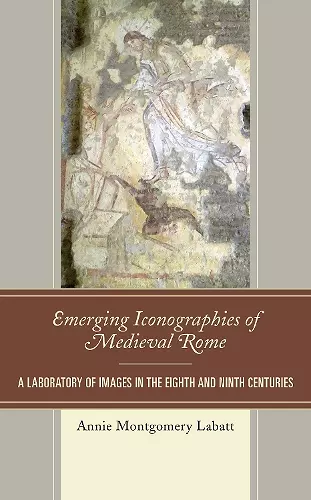Emerging Iconographies of Medieval Rome
A Laboratory of Images in the Eighth and Ninth Centuries
Annie Montgomery Labatt author
Format:Hardback
Publisher:Lexington Books
Published:23rd Oct '19
Currently unavailable, and unfortunately no date known when it will be back
This hardback is available in another edition too:
- Paperback£38.00(9781498571173)

This study explores four iconographical forms from eighth and ninth century Rome, highlighting the city's artistic vibrancy and innovation in Christian imagery, challenging the notion of Rome as merely an Eastern adjunct.
Emerging Iconographies of Medieval Rome delves into the development of Christian iconographies in Rome during the eighth and ninth centuries, focusing on four distinct forms: the Anastasis, the Transfiguration, the Maria Regina, and the Sickness of Hezekiah. The author, Annie Montgomery Labatt, emphasizes the experimentation and artistic innovation characteristic of early medieval Rome, challenging the notion that the city was merely an extension of Byzantine influence. Instead, she presents Rome as a vibrant center of creativity in this transformative period.
Labatt critiques the traditional scholarship that has often relegated Rome to a secondary role in the narrative of medieval art, arguing that prominent mid-twentieth-century scholars have unfairly labeled these emerging iconographies as “Byzantine.” By examining these images through formal and stylistic analyses, alongside the writings of early medieval thinkers, Labatt seeks to restore the significance of Rome’s artistic contributions. She highlights how these iconographies were in the process of being defined and showcased the dynamic artistic environment of the time.
Ultimately, Emerging Iconographies of Medieval Rome serves as a vital reassessment of the period, illustrating that the artistic endeavors in Rome were not simply imitative but rather a rich tapestry of innovation. Labatt’s work invites readers to appreciate the complexity and vibrancy of early medieval Roman art, asserting that it deserves recognition as a central force in the evolution of Christian iconography, rather than a mere adjunct to the East.
This study examines Rome as a center of new artistic production, a laboratory of emerging iconographies. This is in contrast with the views of some prominent scholars who made an a priori assumption of a bifurcated East and West, which turned Rome into a peripheral adjunct of the East. Annie Montgomery Labatt uses new applications of evolutionary thinking to appreciate the significance of `good tries’ that had a momentary `fitness.’ In other words, individual iconographies operated in a `complex adaptive system’ that led some imageries to be replaced by other, more successful ones. Through this lens, the book explores more specifically art in Rome during the eighth and the ninth centuries and four innovative and creative iconographies: the Anastasis, the Transfiguration, the Maria Regina, and the never-recurring Sickness of Hezekiah, the only one of its kind. The book offers a close analysis of the earliest surviving examples of these different iconographies that have been traditionally called proto-Byzantine and shows how their Roman presence is essential, and considers the placement of the different examples in the different spaces of the churches as a way of showing the experimentation occurring. In so doing, the book provides an innovative look at the artistic vibrancy of Rome that was a fertile design landscape, a Rome that allowed varied and vital evolutionary experimentation. Labatt’s insightful reflections break new ground in how scholars should think about Rome in the early medieval period. -- Grazia Maria Fachechi, Urbino University
ISBN: 9781498571159
Dimensions: 233mm x 161mm x 25mm
Weight: 653g
366 pages